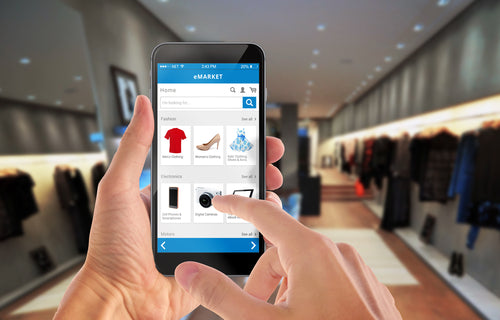Cross-Selling And Upselling Marketing: The Importance for your Vape Shop
Estimated 0 min read
If you’re looking for a way to increase revenue, ROI, and customer loyalty, you might find two overlooked business techniques: cross-selling and upselling. With these easy to implement businesses tactics, you’ll be able to offer more to your customers, no matter if you run a brick and mortar vape shop or an e-commerce vape store.
In this article, we discuss the differences between cross-selling and upselling, when to use these techniques, and how to implement them. In the end, we hope to give you a better understanding of these techniques and how you can create your own upsell and cross-selling strategies. So if you’re ready, let’s get started.
Table of Contents
- Difference between upselling and cross-selling
- When to upsell and when to cross-sell on your vape shop
- Tactics to implement while upselling or cross-selling
- Segment your customers according to their needs
- Benefits for your vape shop and your customers
- Conclusion
Difference between upselling and cross-selling
First, let’s start by defining what cross-selling and upselling are. Although used interchangeably, upselling and cross-selling are two vastly different techniques used in sales and business.
- Upselling: When you upsell, you convince a customer or client to invest in a better version or upgraded version of the product they are currently buying. An example of this will be if a customer plans on buying a disposable vape but ends up purchasing a vape pen of the same brand.
- Cross-selling: In contrast, when you cross-sell, you convince a customer or client to buy additional products related to the primary product they are purchasing. For example, if a customer plans on buying a box mod but also ends up purchasing a tank, a carrying case, and extra coils.
When to upsell and when to cross-sell on your vape shop
Knowing when to upsell and knowing when to cross-sell will ensure you implement these techniques successfully. You don’t want to seem too pushy and drive customers away, but you also don’t want to miss opportunities by not presenting beneficial offers to your clients. The key is finding the perfect time to introduce them, and many times, this comes down to listening to your clients’ concerns.
While this might be a bit harder if you run an e-commerce vape shop, on brick and mortar shops, speaking to your customers and listening to what they are looking for can clue you in on their needs and desires. Suppose a customer has settled for a new box mod precisely because he expressed interest in better cloud production. In the same sale, a savvy employee could also recommend an e-juice with a high vegetable glycerin ratio, which is better for thicker vape clouds, suggesting a cross-sell for the client.
In e-commerce shops, since it’s harder to interact with your clients, smart cross-selling and upselling comes down to when you introduce the additional items or upgraded versions in the customer journey. If we can learn anything from Amazon, the most opportune times to cross-sell and upsell are on the product page and the checkout page.

Tactics to implement while upselling or cross-selling
There are many tactics you can use to practice cross-selling and upselling. Some of these include bundling, limiting options, and following up with email marketing.
- Bundling: You are probably already aware of this, but every time you sell a vape starter kit, you’re already bundling. Bundling is when a product and a few related products are sold together as a complete package. In the vaping world, vape starter kits are the perfect examples of bundles; they come with a device, a charger, and a few e-juices you can try. Try this tactic on your e-commerce store or in your physical store; gather a few of the most commonly bought items together and sell them as a single unit.
- Limiting options: Sometimes, clients or customers, when presented with too many options, tend to freeze and not buy anything. According to a recent study by the Kellog School of Management at Northwestern University, when customers experience too many options, they encounter “choice overload,” which tends to paralyze them into inaction. To combat “choice overload,” they recommend the following:
- Simplify the way choices present: For example, organizing your e-juices by flavor will make it easier for your clients to pick their favorite. Or place them side-by-side so they can see the cons and pros more clearly.
- Make the action of deciding easier: Don’t pressure clients into action by creating time-limits (unless you’re running a time-sensitive offer). By giving them ample time to decide, they are less likely to experience “choice overload.”
- How much do clients know?: Does your client already have an idea of what he wants? For example, he knows he wants a pod system but not whether he should get an open-end or closed-end pod system. Limit his options to only closed-end and open-end pod systems and don’t introduce other types of vapes.
- Following up with email marketing: With email marketing, you can follow-up and cross-sell after the purchase completes. For example, in the receipt email, you add products that complement the purchase, like batteries or a carrying case. You can also use this tactic long after the purchase. For example, if a customer bought a regulated box mod, you can send an email offering coils at a discounted price after a few weeks.
Segment your customers according to their needs

Cross-selling and upselling work best when the suggestions being offered fall on receptive ears. Often this means knowing your audience. Which is why segmenting your customers by their needs is so important. Knowing the types of customers that visit your store can inform the types of items to cross-sell or upsell.
Segmenting can be done on an e-commerce website by separating customers by the total amount of money spent, the items bought, the location they shopped from, etc. By identifying your customers, you will get closer to knowing which things work when cross-selling or upselling online.
Building relationships with your customers can lead to more successful cross-selling and upselling on a brick and mortar shop. Also, by asking questions, you can deduce the type of customer you’re dealing with, whether it’s a veteran vaper or a beginner.
A beginner vaper will probably only be interested in pod systems, disposables, and vape pens. Trying to upsell them to box mod, which they do not know how to use, is probably a bad idea. On the other hand, suggesting to a vaping veteran to upgrade their rebuildable dripping atomizer to a brand new squonk mod could secure a sale. It all comes down to knowing who your customers are.
Benefits for your vape shop and your customers
Not only does upselling and cross-selling increase your revenue, but it also increases customer loyalty, increases ROI, and customer lifetime value.
When upselling and cross-selling happen right, your customers walk away thankful. When you suggest items they will indeed need, they don’t see it as an added expense but rather as a necessary investment and thoughtful suggestion to meet their needs. This process, in turn, increases customer satisfaction, which in turn increases customer retention and loyalty.
Cross-selling and upselling increase ROI because they maximize the investment you made in acquiring every customer. By offering additional items with what could be a single-time purchase, you increase the consumer spending a bit more than initially planned.
Finally, by cross-selling and upselling, you increase the customer lifetime value. A customer who walked away thankful for your suggestions is more likely to come back when they do decide to take that step forward and finally buy a more advanced box mod.
Conclusion
With this brief introduction, we hope you can implement your own cross-selling and upselling techniques in your vape shops and hopefully see a bump in sales and an increase in revenue. The most important thing to remember is that upselling and cross-selling are thoughtful suggestions that will address the customers’ needs. You never want to force a sale on a customer with items that won’t be beneficial, or you’ll see them walking out of the door.







